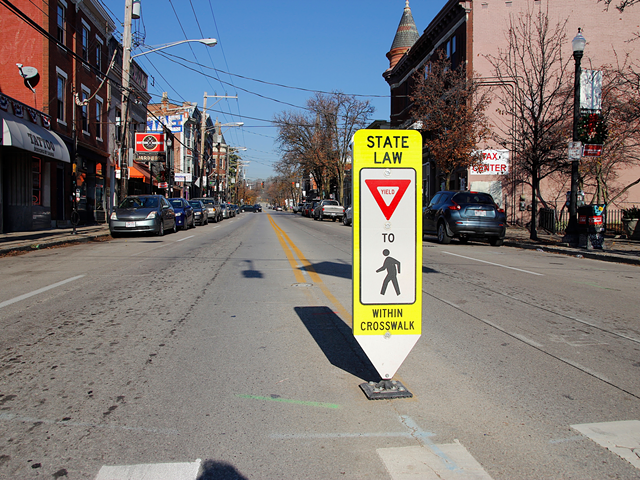Should the city change the way it hands out tax incentives for development? Some Cincinnati City Council members think so. A motion introduced by council members Tamaya Dennard, Greg Landsman and Wendell Young, all Democrats, seeks more information from city administration about how it makes decisions on tax incentives and asks for a report on adding new criteria around affordable housing, environmental standards and wages into the mix.
Dennard says the effort aims to both continue to incentivize development in Cincinnati while making sure people who live in the city's neighborhoods benefit from it and aren't displaced by changes coming to various communities, including rapidly developing ones like Over-the-Rhine, Walnut Hills and others.
"What we're trying to do with this legislation is basically say to developers, 'If you want to get assistance from the city, if you want us to subsidize your development, we're going to ask some things from you in return,' " Dennard says. "Some of those things are affordable housing, higher environmental standards and higher wages for people who are working at these sites, among other things."
Others, however, including some council members, have expressed concern about new asks from the city to developers, saying it could cause development to go elsewhere.
The legislation comes as the city gears up to renegotiate a 1999 agreement with Cincinnati Public Schools about the way it handles abatements. CPS relies heavily on funding from property taxes, and thus is impacted by abatement deals the city makes. CPS and city officials launched talks last June about changes to the city's policy, and abatements were a big topic.
Under the current deal, the city pays CPS $5 million a year up to $100 million to offset tax abatements given to developers to incentivize new projects in the city — a deal reached in 1995 as part of the development of Cincinnati’s two riverfront stadiums, which are tax abated.
CPS can use that money only on capital projects. Some of those developers are also required to provide payments in lieu of taxes (PILOTS) on roughly 25 percent of the valuation of their project — though housing that costs under $330,000 a unit is exempted from that. In return for those payments, the city can offer 15-year property tax abatements on up to 100 percent of the value of improvements or new construction.
Without the deal, the city’s options are more limited: tax abatements at less than 50 percent for up to 15 years, as well as limitations on tax increment financing districts — where tax money is diverted into an account that helps pay for improvements to the area around a property — and payroll tax abatements.
Not everyone likes the current arrangement. Cincinnati Federation of Teachers President Julie Sellers fired off a letter to council in June saying the union is asking for changes.
“Tax abatements may be a useful tool to encourage development in blighted neighborhoods, or during an economic downtown,” Sellers wrote. “But the city’s ongoing grant of lengthy abatements in thriving neighborhoods shortchanges our schools and local services.”
CFT says that even with the $5 million annual payment from the city to the district, CPS is losing about $8.4 million a year on tax abatements. Further, about 20 percent of residential tax abatements end up in Hyde Park and Mount Lookout, two of the city’s wealthiest neighborhoods. Sellers and others say the city needs to change that. The union would like the city to pay the district enough to make up for those abatements, stop abatements in high-income neighborhoods and cut back on the value and duration of many abatements.
Hamilton County Auditor Dusty Rhodes in June said that more than 36 percent of property in the city is tax exempt, representing 10 percent of the city's total property value.
City officials have defended the city's current abatement policies.
“Unquestionably, we can say this agreement is still every day spurring development, growth and generating jobs,” Phil Denning, director of the Department of Community and Economic Development, said at June's joint meeting between city officials and CPS. Though the agreement hasn’t changed much in the past 19 years, Denning says the department has gotten somewhat more conservative about how it structures abatements.
“We’re becoming as a department more aggressive about how we underwrite these deals,” he says.
But Denning in June also admitted the city didn’t have overall numbers for the return on investment for abatements. That’s been an issue in the past — media reports have shown the city doesn’t always have answers about the results of the more than $250 million in various tax deals, grants and other incentives it has given out over the past decade. Denning promised that data on the number and worth of abatements — as well as their payoffs for the city and district — would be available as the district and city work on a new agreement.
Meanwhile, calls have grown outside City Hall for a change to the way the city does abatement deals. A grassroots effort by OTR's Peaslee Neighborhood Center seeks to accomplish some of the same aims as Dennard, Landsman and Young's legislation does via an "equitable development rubric." The community group is currently testing its rubric in several neighborhood councils.
Dennard says the new proposed legislation, set to go before council's Budget and Finance Committee, has similar aims, though it was drawn up independently of Peaslee's effort. The legislation is also just a first step seeking a report from city administration.
Some specific changes to the city's abatement policy that the legislation's authors seek could include requiring LEED Gold or Platinum certification — Silver is all that is required for an abatement currently — and requiring residential developments seeking abatements to provide some units affordable to those with lower incomes at levels specified by the city.
For example, those making below 30 percent of Hamilton County's Area Median Income — which works out to about $15,000 a year for a single person — face a 30,000-unit gap when it comes to affordable rental housing in Cincinnati, according to data from the Ohio Housing Finance Agency.
The lack of affordable housing units in the city combined with rapid redevelopment has led to some displacement of residents in neighborhoods like OTR and Walnut Hills. Dennard says she'd like to find ways to keep that from happening when the city is providing subsidies in the form of tax breaks or other incentives for a development.
"Because of development that has taken place, people have been priced out of the city," Dennard says. "I've said from day one, Cincinnati can be a place where we invite people here — people from the suburbs and other cities, we want them to move to the city — but we also need a place where people can afford to stay. We're losing populations of people who are economically under-served, and a high proportion of those people are African-American. We want to make sure our communities are as diverse and inclusive racially, economically and culturally as humanly possible."






